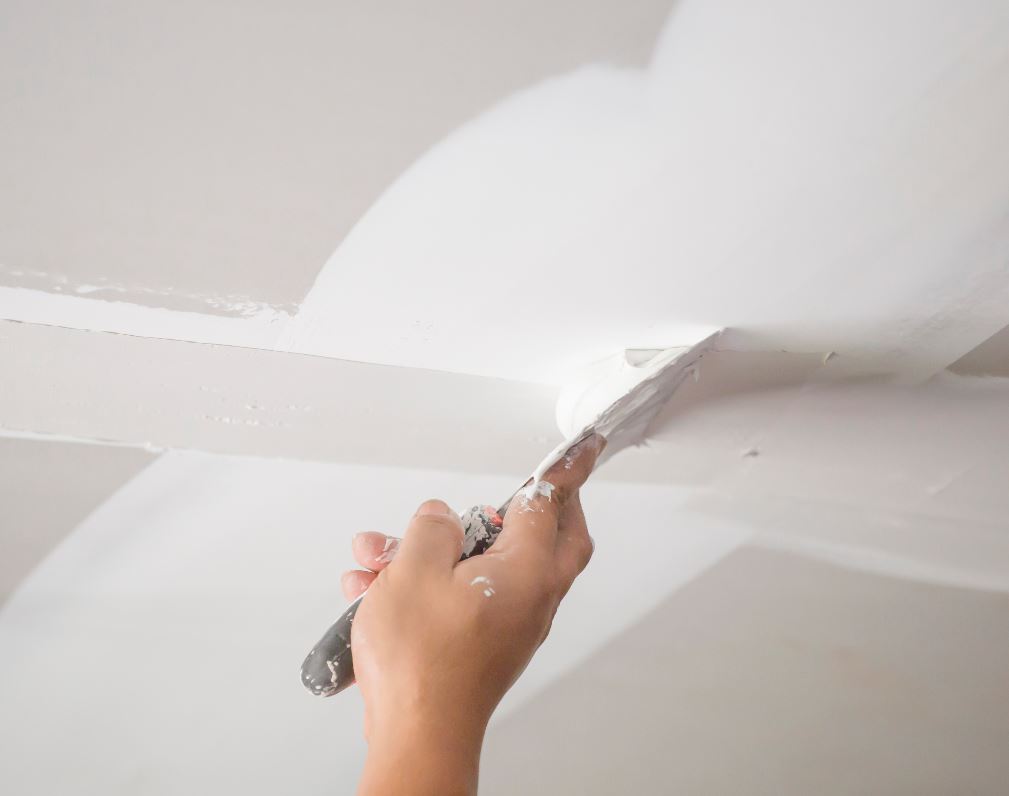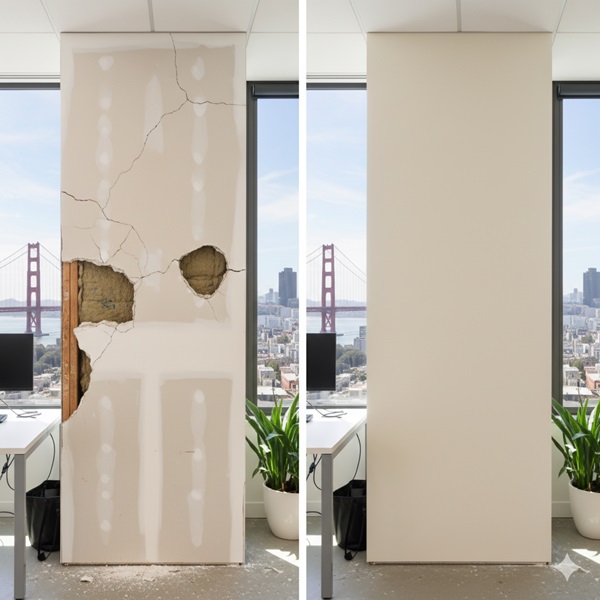A Comprehensive Overview to Learning Drywall Fixing and Setup
This guide uses a detailed exploration of drywall repair service and installment, catering to both amateurs and seasoned specialists. It lays out necessary devices, techniques for patching and hanging sheets, and the important finishing processes. drywall contractor. By recognizing common mistakes, individuals can achieve refined results. Mastering these abilities not only enhances one's home but additionally develops confidence in do it yourself undertakings. What fundamental ideas will ensure an effective task from beginning to end?
Vital Devices for Drywall Fixing and Installation
When starting on drywall fixing and installation, a few important tools can substantially improve the efficiency and high quality of the work. A drywall blade, normally readily available in various dimensions, is important for using joint compound and smoothing joints. A taping blade is also needed for feathering sides and guaranteeing a smooth coating. Additionally, a drywall saw or energy blade permits accurate cutting of drywall sheets to fit any type of room.

Step-by-Step Guide to Patching Holes
Patching holes in drywall is a straightforward procedure that can bring back the wall surface's look and integrity. To start, the area around the opening must be cleansed and any kind of loose debris removed. For little openings, a straightforward spackle or joint substance can be used with a putty knife. Larger openings may need a patch; an item of drywall can be reduced to fit the hole, safeguarded with adhesive or screws, and after that taped around the sides. When the spot remains in place, joint compound is used over the spot and feathered bent on blend with the surrounding wall. After the compound dries out, sanding is essential to accomplish a smooth surface. Finally, the repaired area can be topped and repainted to match the rest of the wall. This technique assures a smooth fixing, boosting the total look of the drywall and maintaining its architectural stability.
Methods for Hanging Drywall Sheets
After efficiently repairing openings in drywall, the next action involves hanging new drywall sheets to create a seamless surface. To achieve this, one must start by gauging the wall surface room precisely and cutting the drywall sheets to fit. It is vital to hang the sheets horizontally for better structural integrity, starting from the top and functioning downwards.
Using a drywall lift can streamline the procedure, especially for ceiling installments. Once placed, protecting the sheets with drywall screws at intervals of regarding 12 inches along the sides and 16 inches in the field is important. This guarantees a firm hold and minimizes the threat of drooping. For edges, the sheets must be cut to fit well, allowing for cleaner joints. It is a good idea to surprise the joints between sheets to enhance the general structure, developing a much more sturdy surface all set for the following stage in the drywall installment process.
Ending Up Touches: Insulation and Mudding
Finishing the drywall setup entails the important steps of mudding and taping, which ensure a smooth and sleek coating. Insulation requires the application of joint tape over the joints in between drywall sheets. Interior Painting. This tape can be either paper or fiberglass harmonize, with each type offering unique benefits. After taping, the next step is mudding, where joint compound, or "mud," is related to cover the tape and fill any kind of imperfections
Using a drywall blade, the compound ought to be spread evenly, guaranteeing a feathery side to minimize noticeable changes. Multiple coats are typically needed, great post to read with sanding in between each layer to attain a smooth surface. Mindful attention during this process is important, as it significantly affects the last look of the wall. With the best technique and perseverance, completion result will be a flawless foundation all set for painting or completing touches.
Usual Mistakes to Stay Clear Of in Drywall Projects

One more typical error is not allowing enough drying time between layers, which can trap wetness and jeopardize the finish. Additionally, overlooking to feather the sides correctly can create visible lines original site and blemishes. Lastly, avoiding sanding or utilizing inappropriate strategies might leave harsh places. By knowing these mistakes, individuals can substantially boost the top quality of their drywall projects and achieve a professional-looking surface.
Frequently Asked Inquiries
Can I Repair Drywall Without Expert Assist?
Yes, one can fix drywall without specialist assistance. With the right devices, materials, and assistance, individuals can efficiently deal with minor repair work. Significant damage may call for expert expertise for perfect outcomes and sturdiness.
Just How Long Does Drywall Compound Take to Dry?
Drywall compound generally takes between 24 to two days to completely dry completely, relying on elements such as moisture and temperature level. Thinner layers might dry out quicker, while thicker applications need even more time for suitable results.
What's the most effective Kind Of Paint for Drywall?
The most effective sort of paint for drywall is commonly a water-based latex paint. It offers exceptional insurance coverage, longevity, and convenience of application, making it suitable for indoor walls while allowing for very easy cleaning with soap and water.

Just how Do I Protect Against Mold And Mildew on Drywall?
To avoid mold on drywall, assurance correct ventilation, control moisture degrees, use mold-resistant products, and quickly deal with any leakages. Routine evaluations and immediate removal of water damages are additionally vital for lasting avoidance.
Is Drywall Recyclable After Removal?
Drywall is recyclable after elimination, gave it is devoid of contaminants like mold and mildew, paint, or various other harmful materials. Recycling centers can refine it into brand-new items, promoting sustainability and minimizing garbage dump waste in building.
When beginning on drywall repair and setup, a couple of essential devices can considerably enhance the efficiency and top quality of the job. After efficiently repairing holes in drywall, the next action involves hanging brand-new drywall sheets to develop a seamless surface area. see post Completing the drywall installation involves the essential steps of mudding and taping, which ensure a polished and smooth coating. Accomplishing a sleek coating in drywall tasks can be tough, and a number of usual errors can threaten the top quality of the work. Yes, one can fix drywall without professional aid.